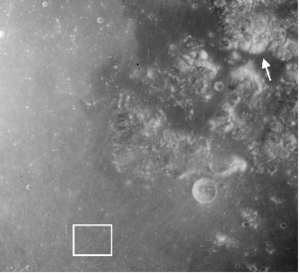
| Project Home | About the Scans | Browse Gallery | Image Map | Support Data | Resources | Ephemeris |
Featured Image - 09/09/2008
Lunar Lava Tubes: Home Sweet Home?
In southeastern Mare Serenitatis, not far from the Apollo 17 landing site in the Taurus-Littrow Valley , lie features thought to be lunar lava tubes. These features are found in a variety of lunar mare environments. Scientists first suggested drained lunar lava tubes as possible human habitats in 1962, and since then the tubes have remained at the center of both geological debate and the future of a sustained human presence on the Moon.
Figure 1. Southeastern Mare Serenitatis. The arrow points to the Apollo 17 landing site. The box contains the location of lava tubes. (Apollo Image AS15-M-1115 [NASA/JSC/Arizona State University])
Figure 2. Close-up view of possible lava tubes in Mare Serenitatis. This particular lava tube complex contains 5 distinct sections. The largest is approximately 0.88 km long, 0.5 km wide, and has an estimated roof thickness of at least 40 meters.(Apollo Image AS15-M-1116 [NASA/JSC/Arizona State University])
Future lunar missions, especially the high-resolution (0.5 m/pixel) from the Lunar Reconnaissance Orbiter Camera will clarify the geological mechanism behind lunar lava tube formation and identify locations with hollow lava tubes that will help humans survive on the Moon for extended periods of time.
References: C.R. Coombs and B.R. Hawke (1992), "A Search for Intact Lava Tubes on the Moon: Possible Lunar Base Habitats." 2nd Conference on Lunar Bases and Space Activities (LPI): 219-229.
Tweet
|
|
Space Exploration Resources |
|
 LPI LPI
|

